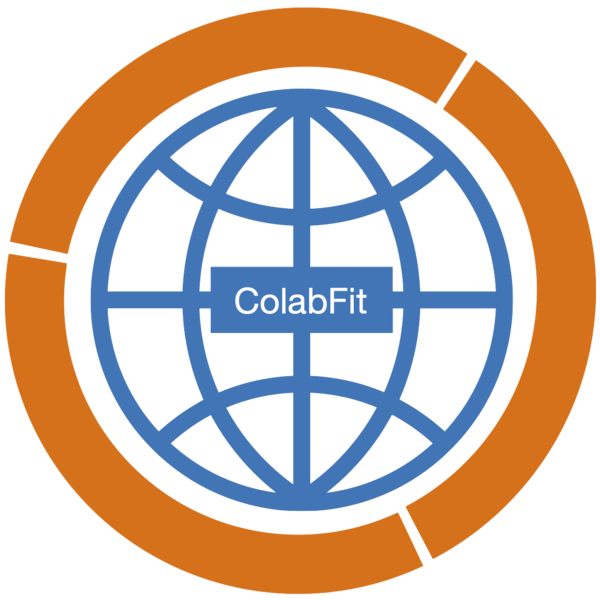 |
The ColabFit Exchange: Data for Advanced Materials Science |
Welcome to the ColabFit Exchange! This is the world’s largest hub for the discovery, exploration and submission of datasets for the development of machine learning interatomic potentials (MLIPs) for materials science and chemistry. ColabFit datasets are carefully vetted and cleaned, and made available in a variety of standard formats including LMDB, Parquet and xyz. Content on the ColabFit Exchange is open source and freely available.
Datasets
Configurations
Downloads
Atoms
Advanced Search
Results: 463
OMat24_train_aimd_from_PBE_3000_nvt
Download Original Data Files
32.0 GB
Download Dataset Parquet Files
13.8 GB
Download Dataset XYZ Files
20.9 GB
OMat24_train_aimd_from_PBE_3000_npt
Download Original Data Files
24.8 GB
Download Dataset Parquet Files
20.7 GB
Download Dataset XYZ Files
16.2 GB
ANI-1x
Download Original Data Files
4.4 GB
Download Dataset Parquet Files
319.3 MB
Download Dataset XYZ Files
212.5 MB
sAlex_validation
Download Original Data Files
393.0 MB
Download Dataset Parquet Files
356.1 MB
Download Dataset XYZ Files
244.4 MB
OMat24_train_aimd_from_PBE_1000_npt
Download Original Data Files
23.4 GB
Download Dataset Parquet Files
16.1 GB
Download Dataset XYZ Files
11.0 GB
OMat24_train_rattled_1000
Download Original Data Files
19.2 GB
Download Dataset Parquet Files
11.7 GB
Download Dataset XYZ Files
8.7 GB
OMat24_train_aimd_from_PBE_1000_nvt
Download Original Data Files
22.2 GB
Download Dataset Parquet Files
15.2 GB
Download Dataset XYZ Files
10.4 GB
ISO17_NC_2017
Download Original Data Files
634.8 MB
Download Dataset Parquet Files
702.9 MB
Download Dataset XYZ Files
461.9 MB
DeePMD_SE
Download Original Data Files
585.7 MB
Download Dataset Parquet Files
639.2 MB
Download Dataset XYZ Files
711.7 MB
OMat24_validation_aimd-from-PBE-1000-npt
Download Original Data Files
260.2 MB
Download Dataset Parquet Files
151.0 MB
Download Dataset XYZ Files
104.8 MB
OMat24_validation_aimd-from-PBE-1000-nvt
Download Original Data Files
249.8 MB
Download Dataset Parquet Files
145.5 MB
Download Dataset XYZ Files
100.9 MB
OMat24_validation_rattled_1000
Download Original Data Files
214.4 MB
Download Dataset Parquet Files
121.4 MB
Download Dataset XYZ Files
91.0 MB
OMat24_train_rattled_300_subsampled
OMat24_train_rattled_500_subsampled
JARVIS_AGRA_CO
Download Original Data Files
174.8 KB
Download Dataset Parquet Files
294.1 KB
Download Dataset XYZ Files
213.0 KB
OMat24_validation_rattled_500
Download Original Data Files
132.1 MB
Download Dataset Parquet Files
72.0 MB
Download Dataset XYZ Files
53.2 MB
OMat24_validation_rattled_300
Download Original Data Files
119.3 MB
Download Dataset Parquet Files
64.9 MB
Download Dataset XYZ Files
47.8 MB
JARVIS_AGRA_CHO
Download Original Data Files
186.6 KB
Download Dataset Parquet Files
310.4 KB
Download Dataset XYZ Files
176.4 KB
OMat24_validation_rattled_1000_subsampled
Download Original Data Files
74.6 MB
Download Dataset Parquet Files
40.8 MB
Download Dataset XYZ Files
29.7 MB
OMat24_train_rattled_1000_subsampled
OMat24_validation_aimd-from-PBE-3000-npt
Download Original Data Files
287.0 MB
Download Dataset Parquet Files
201.7 MB
Download Dataset XYZ Files
159.0 MB
JARVIS_AGRA_COOH
Download Original Data Files
247.4 KB
Download Dataset Parquet Files
398.5 KB
Download Dataset XYZ Files
230.0 KB
JARVIS_AGRA_OH
Download Original Data Files
243.0 KB
Download Dataset Parquet Files
703.2 KB
Download Dataset XYZ Files
453.8 KB
JARVIS_AGRA_O
Download Original Data Files
253.0 KB
Download Dataset Parquet Files
624.7 KB
Download Dataset XYZ Files
245.2 KB
OMat24_validation_aimd-from-PBE-3000-nvt
Download Original Data Files
370.2 MB
Download Dataset Parquet Files
258.9 MB
Download Dataset XYZ Files
204.3 MB
OMat24_validation_rattled_relax
Download Original Data Files
117.1 MB
Download Dataset Parquet Files
71.5 MB
Download Dataset XYZ Files
48.5 MB
OMat24_validation_rattled_300_subsampled
Download Original Data Files
66.8 MB
Download Dataset Parquet Files
36.6 MB
Download Dataset XYZ Files
26.5 MB
OMat24_validation_rattled_500_subsampled
Download Original Data Files
76.6 MB
Download Dataset Parquet Files
41.9 MB
Download Dataset XYZ Files
30.5 MB
